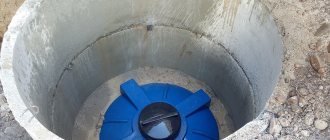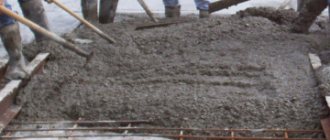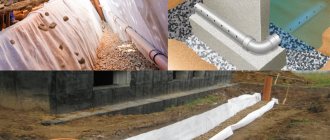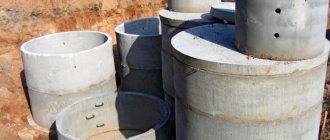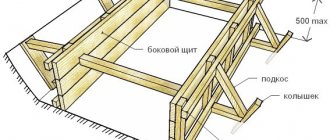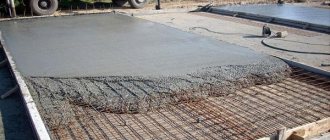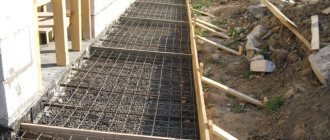The well has long been the most accessible source of water. This is due to its long service life, drinking water quality and ease of development.
Owners of private residential buildings and summer cottages with a water supply connected to a central water supply system do not face a number of problems typical of people who have their own well.
The technology for digging a well has remained unchanged for decades, as have the main problems that owners of hydraulic structures have to solve. One of them is a decrease in water levels. The only solution is to deepen the well to the next aquifer.
When to deepen a well
Not all cases require deepening the well, as this action may not solve the problem of water shortage. There are at least four good reasons why a well needs to be deepened to the next aquifer.
- There is no possibility to dig a new well.
- The depth of the well column has more than ten rings.
- The well partially or completely dries up.
- In one day, the well's filling capacity dropped to one ring.
A well that requires deepening
In almost all other cases, you will need to dig a new well.
Deepening an old well made of concrete rings
Question:
The well is more than 10 years old, I dug it myself, the soil is clean sand, I reached a quicksand of 5.5 m and stopped. Concrete rings diameter 1 meter. There was a need to deepen it by 2 meters, but the rings in the sand are now tight. Is it possible to push through them with a shovel, (bucket) of some tractor, for example Kirovets, if I dig up the bottom?
Victor, Samara.
Answer:
Hello, Victor from Samara!
Several years after a well is dug, the soil around its rings becomes so compacted that settlement is practically impossible. Therefore, this option cannot be ruled out - you dig under the bottom ring, it will sit down even without pressure from above, but all the other rings may not sit down. There will be a gap between the last and penultimate rings. And then what?
However, you can try. As they say, “there is no trick against scrap.” “Kirovets” with the appropriate attachments is a powerful technique; it can push through the heels of reinforced concrete rings, if the soil characteristics allow this.
That is, the algorithm is as follows - you dig (with all the precautions of this process) under the lower ring by about 10-15 centimeters. Then, using a technique, press down the upper end of the ring protruding above the surface of the earth. Through a gasket in the form of thick edged boards. Otherwise, upon impact, there is a possibility that the concrete of the ring will split.
And do this gradually, digging out no more than a couple of tens of centimeters of soil under the lower ring. With alternating work of equipment from above.
But do not forget that even if the work progresses successfully, the cost of renting equipment is decent, and it will take more than one day to go deeper.
“Kirovets” will not stand and wait for you to manage.
I won’t say that I did such things. The most that has been done is to use the “UDS” to plant four reinforced concrete rings with a diameter of one and a half meters into freshly dug sandy soil.
With light blows of the ladle, all the rings were freely deposited a meter away.
So everything is at your own risk.
/ Naturally, you can try to reconstruct your well without the involvement of technology. Why continue to dig a few centimeters under the lower ring and try to push the rings down using pry bars and wedges inserted between the upper rings into the gap. But no one can guarantee success. Everything will depend on the density of the soil. If you're lucky, you'll be lucky. No means no.
I won't say anything else. Good luck!
Construction in Moscow and Moscow region
We work with a guarantee! Wide range of construction services.
Foundation, walls, ceilings, roofing, turnkey! +7 (905) 797-20-34
luxurycomfort.ru
Other questions on the topic of wells:
- Make a well at your summer cottage with your own hands
- Deepening and strengthening a well from rings
- How deep should a key well go?
- Sewage well made of concrete rings
- There is no water in the well
- Little water in the well in the new well
- Well - deepen an old one or build a new one
- They dug a well but there is no water
- Water left after deepening the well
- Well in karst terrain
- Restore an old well from a log house
- Drainage well in the basement of a house near the river
- Water with a lot of iron in the well
- Dig a new well in place of the old one that was filled in
- Shift of well rings
- Pumping water from a well in spring
- Well without water
- How to pump a new well
- Cleaning a well from a savage stone
- Removing rust from water in a concrete well
- When digging a well, it fills with fine sand
- Is it possible to fill up a well with the corpses of a cat and dog?
- How to deal with quicksand in a well
- Sealing joints in a concrete well
- Increasing water in the well
- Replacing a wooden well with a concrete one
- The water level in the well has dropped
- Repair of an old oak well
- How to install a reinforced concrete ring on a well frame
- How to fill up an old well
- Yellow water well cleaning
- Restoration of a well made of reinforced concrete rings
- Well from tires replacement with reinforced concrete rings
- Well - is it worth digging through clay?
- Repair of an old oak well
- Rusty water in a well
- How to recognize quicksand when digging a well
- Digging a well for sewerage
- How to increase water flow in a well
- Water supply to a dacha from a well
- Speed of water collection in a well
- Well on quicksand
- DIY well cover
- The well collapsed, what should I do?
- Where to dig a well
- There is no water in the well
- Hydrogen sulfide in a well
- Water left after cleaning the well
- The water has left the well
- Well made of pipes or rings
- Well depth
- Deepening the well
- Electric pump in a well
- How deep to dig a well
- Questions when digging a well
- Deepening an old well made of concrete rings
- Caught on quicksand in a well
- Iron pipe well repair
- Low water level in the well
- Deepening a well made of natural stone
- Two wells in one well
- Problem with a well on Lake Baikal
- Deepening an old well
- How to destroy an old well
- Blue clay in a well
- What depth should the well be
- Freezing water in a well
- Problems after well repair
- Water slowly collects in the well
- Water is leaving the new well
- Ring with crack for well
- Lowering reinforced concrete rings into an old well frame
- New well made of reinforced concrete rings
- The problem when digging a well is that the water causes sand
- White clay in a well
- Smell from well water
- Well water quality
- A reinforced concrete ring got stuck while digging a cesspool
- Floater in the well
- Deepening a well in quicksand
- Problem with deepening the well
- Well in a well
- Little water in the well
- How to draw a ditch
- Displacement of well rings what to do
- Deviation of rings when digging a well
- Service life of a well made of reinforced concrete rings
- The earth around the well settles
- Well inside the house
- Well water problem
- Do I need to pump water out of a well?
- Drinking well in a swampy area
- Well cleaning
- Quicksand in the well
- Black clay in the well
- How to lower a well ring
- Limestone in a well
- Well on a site in a lowland
- Treatment of the well inside
- How to dig a well yourself
- Construction of a well on a high hill
- Over the winter the rings of the well collapsed
- Should I dig a new well next to the old one?
- Renewing water in a well
- How to lower the well rings
- How to fasten the well rings
- Problem when digging a well
- How to deepen a well below the water level?
- How to reset squeezed out well rings?
- How to settle well rings?
- How to treat rings for a well?
- Problems when cleaning a well
- While digging a well, a large boulder came across. What to do?
- Problems of laying concrete rings during well construction
Wells
Well for drinking water
All questions to Semenych about construction
Semenych (author of materials)
Our site is regularly updated with interesting and unique materials and articles on the topics of lumber, building materials and works, the author's opinion and knowledge of a real coven with more than 15 years of experience are provided. There is a section - funny stories of shabashniks. If you would like to receive information about this, subscribe to our website's newsletter. We guarantee that your address will not be shared with third parties.
Apartment renovation in Moscow and Moscow region
We work with a guarantee! Wide range of repair work.
Professional craftsmen. +7 (905) 797-20-34
luxurycomfort.ru
| Country house | Bath |
| For the dacha | Tool |
| Materials | Tales |
| Foundation | Log houses |
| Roofs | Insulation |
| Walls | Siding |
| Floors | Cellars |
| Attics | Doors windows |
| Stairs | Extensions |
| Wells | Toilets |
| Balconies | Loggias |
| Condensate | Flooding |
| Fences | Kennels |
| Sidewalk | Birdhouse |
| Adobe | Carts |
| Garages | Barn |
| Greenhouses | Bath |
| Swing | Brazier |
| Shower |
| Horizontal bar |
Preparatory work
There are several reasons for water loss. Water may drain due to prolonged drought. Also, water may drain due to the close location of an artesian well during periods of high water standing. Before you decide to deepen your well, it is important to determine whether the problem is temporary or not. If the water has gone and it has been gone for a long time, then you will have to dig.
To begin deepening a well, some important procedures must be performed. For example, it is necessary to assess the actual condition of a well. You should also check the soil's ability to hold rings and determine the new groundwater level. These are the main factors to consider before getting started. When all the calculations have been made correctly, then you can begin to deepen the well to its maximum depth. In most cases it can reach three meters.
Note!
Without the correct calculations, deepening a well can be a waste of time and money.
Ring offset
The deepening process itself will be logical if the well has no more than fifteen rings that are not shifted to the side relative to each other. If this displacement is small, then first you will need to align the entire column. To do this, at the beginning of work, install staples at each seam of the water intake column. This will prevent the column from breaking. Moreover, the water-lifting structure should be removed, and if the top has a house, then it is best to remove it.
A few important rules for proper work
- Considering the fact that the depth of the water source is increased when the master directly descends into the mine, it is necessary to take care of high-quality equipment. A helmet is a must. Otherwise, an accidentally dropped bucket of soil can cause serious injury.
- Before carrying out work (every time), it is necessary to check all safety cables. If one of them wears even minimally, it is worth replacing the ropes and fasteners.
- The master who will deepen the water source must be tied to insurance. This guarantees a safe descent.
- Before deepening a well, you must first completely pump out the water from it.
- And it is worth considering that there may not be enough oxygen in the water well shaft. Therefore, it will have to be ventilated. To do this, either lower a fan into the face and drive out the air masses a little, or use a simple sheet, which is lowered and raised from the well several times like a fan.
You can do this yourself!
Almost any well can be deepened with your own hands. To do this, you can install smaller rings, but only if the entire column is smooth and has no displacements or curvatures. A bracket is mounted on the bottom seam. This will prevent rings with a smaller diameter from settling on the barrel. Next, the trunk is dug inside the well into three rings. After this process, new rings are installed and secured with staples. The junction of two columns is also connected using staples. They will not allow the main column to sag in case of soil shrinkage. At the very end of the work, the bottom of the well is covered with pebbles. It will act as a filter. Before starting the well, all new seams should be caulked.
Pumping
So, to complete this work you will need a set of the following tools and materials:
- shovel with a short handle,
- water pump,
- bumper,
- winch for lifting soil,
- ladder, preferably rope,
- a winch that can withstand a load of up to six hundred kilograms,
- lighting,
All this will allow you to complete the work quickly, efficiently and efficiently.
Repair rings
One of the effective means of deepening a well is the use of repair rings. However, they should be smaller in diameter. If the diameter of the rings of an already finished well is one meter, then rings of 0.7 meters should be used for deepening. This is important, otherwise the new rings will not be able to penetrate deeper. In some cases, rings with a diameter of 0.80 meters can be used. But this is only if the shaft does not have ring displacement. The standard height of the rings can be 0.90 or 1 meter.
Scheme of deepening using repair rings
Note!
If the shaft misalignment is large, then it is recommended to use rings of even smaller diameter up to 0.70 meters.
However, in this case the gap between the structures may be too large. It can be leveled with pebbles or stone.
Some, in order to simplify their already labor-intensive work, follow the path of least resistance. They dig up the bottom ring, hoping that the column will sag, and build up with new rings from above. However, as practice shows, this is not entirely the right decision. After all, as the column moves forward, it can hang and cling tightly, so that later you will have to make much greater efforts to somehow get out of this situation. If you deepen the well using the repair ring method, the water level may return to its original state. But such work can be one-time. If you do not want to encounter this, then it is best to deepen the well yourself to the maximum depth and lower the new rings down.
Schematic diagram
So, all of the above work can be divided into several stages:
- The shaft is checked for external protrusions that may interfere with the descent of the rings.
- Using a metal plate measuring 4x40x300 mm, the column is scraped.
- Four such plates should be installed on each seam, securing them with a 12 mm anchor bolt. Holes are pre-drilled.
Note!
This stage is important, since the plates will not allow the columns to break if the supporting layer begins to move during deepening.
- When the column is sufficiently well secured, a bottom filter is selected.
- Then digging for repair rings is carried out until the wall of the new tunnel begins to collapse.
- At this stage, the rings are lowered.
- If necessary, the column can be extended from above.
- To prevent the old column of rings from sliding onto the new repair one, it is recommended to connect them with corner brackets.
- At the very end, the filter is backfilled, as well as all seams are putty.
Note!
The ideal time for carrying out such work is considered to be autumn/winter. It is during this period that the water is at its lowest level. This will allow the new rings to be installed as deep as possible.
Determining the diameter of the rings
Deepening the well involves selecting the diameter of the rings, which are made of concrete. These are the ones that should be used to carry out the work. This indicator should be less than the diameter of previously installed structures. Rings with a less impressive diameter, which is 80 cm, are used if the shaft is straight along its entire length. The height of the rings of a given diameter can be equal to 90 cm. When using rings of the KS-8.9 or KS-8.10 brands, it will be possible to minimize the gap between the components of the shaft, making it equal to 3 cm. If the shaft is skewed in the area of the rings, then you should prefer products that are even less impressive diameter This figure should be equal to 70 cm. This increases the gap between the previously installed and new rings. You can get rid of it using pebbles or natural stone.
Quicksand is not a problem!
Shield for quicksand
In the presence of quicksand soil, work should be carried out extremely carefully. Moreover, it is not advisable to risk your life without effective assistive mechanisms available. It will be possible to achieve the desired result. However, it is possible.
Dredging in floating soils
To achieve the required result and pass a difficult section of soil, you should speed up your work. In this case, an additional ring is used as a load. The technology of the deepening process in this case is similar to that described above. You just need to have special equipment that will allow you to extract a large volume of sand from the mine at one time.
Interlocking concrete rings into a single unit
This is what will allow you to get the job done quickly and efficiently. To complete the job successfully, one important factor plays a role, which is the contact of the repair column with the hard rock of the quicksand. The chance of getting there is small, but it is possible. To do this, you can do the following: A raft made of deciduous trees is laid at the bottom. Afterwards the filter is removed. As a result of these actions, the water inflow will be greater than at the start of repair work. This technology is also used in cases where there is clay quicksand at the base.
“Filter” recess method
The "filter" deepening method is another effective method of deepening a well. To do this, you will need to purchase a plastic or metal pipe Ø50 cm and one meter long. It should be perforated and then covered with fine mesh, preferably stainless steel. Then at the bottom of the well you need to dig out the earth with a bailer.
Filter
As the filter deepens, it will settle. Gradually the recess will be completed to the required depth.
Deepening the well
Preparatory work
Before deepening an old well, it is necessary to carry out preparatory work:
- First of all, you need to install staples between all the seams of the rings to prevent the well column from breaking during the deepening process.
- After this, it is necessary to dismantle the ground part of the structure (house). If there is water-lifting equipment, it must also be dismantled.
After all these operations, you can proceed directly to deepening.
The photo shows a perforated pipe
Filter method
This method involves the use of plastic or metal pipe.
The instructions look like this:
- First of all, you need to prepare a pipe with a diameter of 50 centimeters and make holes in it.
- Then the pipe is covered with a stainless steel mesh and thus a homemade filter is obtained. You can, of course, purchase a finished product made by specialists, but its price will be much higher.
- Next, the pipe should be lowered to the bottom.
- After this, the soil is removed from the pipe using a bailer, which allows it to be deepened to the required level.
Essentially, this method involves making a well with a casing pipe inside the structure. You can do the bailer yourself.
This tool has a simple design - a regular pipe with a check valve. The baking powder should be located at the bottom of the bailer.
The operating principle of the tool is as follows:
- The projectile is thrown to the bottom of the pipe.
- Then it is removed to the surface along with the soil.
Well ring
Undermining method
This deepening option consists of several stages of work:
- First of all, it is necessary to pump out all available water from the bottom of the well.
- Then you need to go down to the bottom and dig up the soil with your own hands using an ordinary shovel, while the selected sand must be transported to the top.
- Gradually, the lower rings settle down, and at the top there is space for installing new casing elements of the same diameter. This process is quite long and requires careful execution of the work, since it is extremely important to deepen the well correctly, otherwise you can forget about the possibility of using it.
Scheme of recess with rings of smaller diameter
Drilling with casing rings
With this method, as in the previous case, it is necessary to go down to the bottom and select the soil, however, the main rings are not dug, and the soil is strengthened with rings of smaller diameter. The lower casing, in this case, must necessarily overlap the upper one.
In all cases, as mentioned above, it is necessary to deepen the bottom to the maximum permissible depth so as not to return to this issue.
Advice! If the soil is dense, then the recess is made with an open shaft, that is, without casing, and the rings are installed after completion of the work.
Weigh everything carefully!
As can be seen from the above, the work of deepening wells in a dacha with your own hands is very complex and difficult. If you do not have experience, then it is better not to take on the job in a hurry. It may be more cost-effective to turn to specialists. If you still decide to do this work yourself, then you should carefully consider each stage of the work. As for the choice of material that will act as a filter, you can use fine-grained crushed stone, sand concrete and coarse sand.
Koepka
So, if you already have experience in deepening a well in your country house, leave your comments at the end of the article. Successful work to you!



